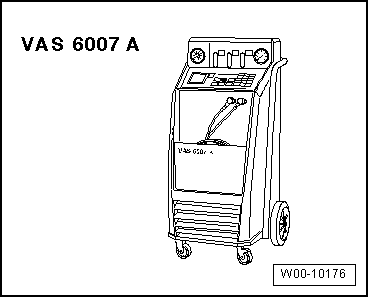Volkswagen Polo Service & Repair Manual: A/C System and Refrigerant R134a Safety Precautions
| A/C Service Station -VAS6007A- (and further or current A/C
Service Station) |
| Refer to the Workshop Equipment Catalog. |
 WARNING
WARNING
| It is recommended to have an eye-flushing bottle
available. |
| If liquid refrigerant has come in contact with your
skin and eyes, immediately flush with cool water for 15
minutes. Afterwards instill eye drops and consult a
doctor immediately, even when the eyes are not hurting. |
| The doctor must be informed that the injury was
caused by refrigerant R134a. Should refrigerant come
into contact with other parts of the body despite
compliance with safety regulations, these must likewise
be rinsed immediately for at least 15 minutes with cold
water. |
| Work on refrigerant system should only be performed
in ventilated areas (workshops). Turn on the exhaust gas
ventilation system |
| Refrigerant must not be stored in low-lying areas
such as cellars or in their entry ways or windowsills. |
|
| Do not attempt repair on filled air conditioning systems by
soldering, brazing or welding. This applies also for welding and
soldering work on the vehicle, in the event that parts of the
A/C system may heat up. When performing paintwork repairs, the
temperature in the drying booth or preheating zone must not
exceed 80 °C (176 °F). |
| Exposure to heat increases the pressure in the system, which
could cause the pressure relief valve to open. |
| – |
Discharge refrigerant circuit with A/C service station. |
 Note Note
| Always replace damaged or leaking A/C system components. Do
not attempt to repair them by soldering, brazing or welding. |
| Refrigerant containers (for example, charging cylinders of
A/C service station) must never be subjected to excessive heat
or exposed to direct sunlight. |
| – |
Vessels must never be completely filled with liquid
refrigerant. Without sufficient room for expansion (gas
cushion), vessels will rupture with devastating effect in the
event of an increase in temperature. Refer to
→ Chapter „Refrigerant R134a Characteristics“. |
| Refrigerant is never to be transferred to systems or vessels
in which air is present. |
| – |
Evacuate systems and vessels before charging with
refrigerant. |
|
|

|
Make sure the shut-off valves are closed before connecting
the charging system to the air conditioning system.
Make sure the process is finishe ...
Follow the instructions for the workplace. They should be
displayed in the workplace.
Ensure absolute cleanliness when working.
...
Other materials:
Brush Grinder Set -VAS6776
Definition:
Brush Grinder Set -VAS6776-
Product Description:
The device is used to clean surfaces and remove corrosion in
hard to reach areas. For example, it is suitable for joints,
grooves, ...
Tyre damage
First read and observe the introductory information
and safety warningsDamage to tyres and rims is often not readily visible.
Any unusual vibrations or signs that the car is pulling
to one side may indicate that one of the tyres is damaged .
Reduce your speed immediately if you suspect th ...
Aquaplus Design and Multi-Color Paintwork
In order to achieve error-free design and multi-colored
paint applications using Aquaplus solid, metallic, pearlescent
base paint, pay attention to the important notes and in some
cases use special tools.
Preparation:
...
© 2016-2025 Copyright www.vwpolo.net

 Note
Note Extraction and Charging System Safety Regulations
Extraction and Charging System Safety Regulations Refrigerant Circuit, General Precautions
Refrigerant Circuit, General Precautions
 WARNING
WARNING